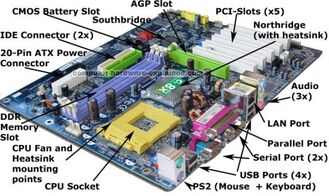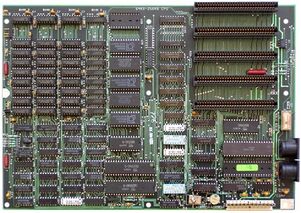WELCOME The Motherboard ,BY- MUKESH KUMARM, BATCH 06[]
In a computer, the motherboard is the underlying circuit board to which everything connects (either directly or through wires). Without the motherboard, a computer cannot work. The motherboard allows all the parts of the computer to communicate, and can be thought of as part of the computer's "skeleton".

In order to connect the parts of the computer, the motherboard needs to have a certain shape and layout. This is called the form factor. The form factor controls where the necessary parts of the computer are placed on the motherboard. The CPU is the most important part that the motherboard holds; it acts as the brains of the computer. Parts such as the chip set (located near the CPU), connectors or USB ports (which allow Peripherals such as a mouse or a keyboard to connect to the computer), expansion cards (on the side of the motherboard), and the Power Supply (connected to the motherboard by cables) also have their own place on the motherboard.
The motherboard uses buses (simple circuits) to transfer data from one part of the computer to another. In order to transfer information quickly, the bus needs to be able to handle a great deal of information at one time. The speed of how fast data can be transferred through the bus is measured in megahertz (MHz), and most buses run from 66 MHz to 800 MHz.

The first motherboard to be used in a computer was produced in 1981, by IBM. Named the IBM "Planar" Breadboard, it wired chips together, and housed the RAM and the CPU (see picture >).
As time went on, the motherboard layout was perfected; in 1995 Intel released a newly designed motherboard (called the ATX Form Factor) that made the parts of the computer interchangeable, thus allowing for more space inside the computers.

Ever since then, motherboards have been steadily improving. In 2009, VIAs Mobile-ITX, the smallest ever motherboard form factor was released, measuring 60mm by 60mm (see picture >). This is a great improvement, because motherboards, just like all the parts of a computer, used to be huge.
Hopefully in the future we will be able to improve even more upon these essential parts of our technological world.
[]
Information Sources[]
http://computer.howstuffworks.com/motherboard.htm
http://wwstechnology.wikia.com/wiki/Motherboard
http://visual.ly/history-computer-motherboard
Picture Sources[]
IBM "Planar" Breadboard:
VIAs Mobile-ITX: